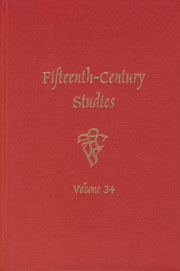Book contents
- Frontmatter
- Contents
- Essays
- 1 The Current State of Research on Late-Medieval Drama. 2007–2008: Survey, Bibliography, and Reviews
- 2 Poetry as Source for Illustrated Prose: The 1519 Strassburg Wigoleis vom Rade
- 3 The St. Edith Cycle in The Salisbury Breviary (c.1460)
- 4 L'épanouissement de l'histoire au quinzième siècle en France
- 5 Escuelas de traducción en la Edad Media
- 6 Ten Poems from the Gruuthuse Songbook (c.1462)
- 7 Louis XI, A French Monarch in Pilgrim's Garb: Badges
- 8 Robert Henryson's Morall Fabilles: Irony, Allegory, and Humanism in Late-Medieval Fables
- 9 Defining Violence in Middle English Romances: Sir Gowther and Libeaus Desconus
- 10 Presencia y Ausencia de los Judíos en los Sermons de quaresma de Vicente Ferrer
- 11 “Als ich dich vor gelert haun”: Conrad Buitzruss's Recipe Collection in Manuscript Clm 671 (Munich)
- 12 Book Reviews
8 - Robert Henryson's Morall Fabilles: Irony, Allegory, and Humanism in Late-Medieval Fables
from Essays
Published online by Cambridge University Press: 05 September 2013
- Frontmatter
- Contents
- Essays
- 1 The Current State of Research on Late-Medieval Drama. 2007–2008: Survey, Bibliography, and Reviews
- 2 Poetry as Source for Illustrated Prose: The 1519 Strassburg Wigoleis vom Rade
- 3 The St. Edith Cycle in The Salisbury Breviary (c.1460)
- 4 L'épanouissement de l'histoire au quinzième siècle en France
- 5 Escuelas de traducción en la Edad Media
- 6 Ten Poems from the Gruuthuse Songbook (c.1462)
- 7 Louis XI, A French Monarch in Pilgrim's Garb: Badges
- 8 Robert Henryson's Morall Fabilles: Irony, Allegory, and Humanism in Late-Medieval Fables
- 9 Defining Violence in Middle English Romances: Sir Gowther and Libeaus Desconus
- 10 Presencia y Ausencia de los Judíos en los Sermons de quaresma de Vicente Ferrer
- 11 “Als ich dich vor gelert haun”: Conrad Buitzruss's Recipe Collection in Manuscript Clm 671 (Munich)
- 12 Book Reviews
Summary
A fable is a narrative episode (resulting in a moral), in which animals usually appear with the mental faculties of human beings but with their own physical characteristics. At times, humans are present with or without animals. This type of literature was particularly developed among the Greeks. Many of the most ancient fables have continued to be popular, in unbroken line, till the present day, including in animal epics. The earliest known fabulist was Aesop, a slave from the Island of Samos in the sixth century B.C., according to the testimony of Herodotus (II, 134). (The editors.)
Poems that present themselves as being self-interpreting offer a unique challenge: does the reader take a poem's allegory of its own narrative as the authoritative reading, or treat the moral's mechanism as a device that supports or strains against the rest of the poem as part of a literary aim? In our age works like Stoppard's The Real Inspector Hound or Nabokov's Pale Fire deploy mock commentary for the sake of interrogating the critical enterprise, and that artistic strategy might prove beneficial when examining certain medieval works. Rita Copeland argues that scholastic commentary appended to classical works has the function of usurping textual authority “by reconstituting the argumentative structure of the text.” While this claim holds true for Christian allegorizations of pagan narratives, one must ask whether such a principle holds equally true for works where the poet himself has written the commentary. Next, one should question whether it is the poem carrying the interpretive authority or whether that mechanism is but one piece of an integrated work of art, one piece of the puzzle the poet asks the reader to assemble.
- Type
- Chapter
- Information
- Fifteenth-Century Studies , pp. 133 - 147Publisher: Boydell & BrewerPrint publication year: 2009

